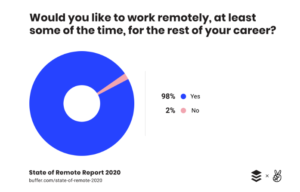First a caveat – yes there are jobs that by their very nature do not support remote working but there are more and more that can. And to be honest, in many cases, it is not the nature of work or the availability of the required technology that is holding companies back, rather it is company culture biases. It seems that many executives and decision-makers in companies look on remote working as something that they have to tolerate in certain circumstances rather than embrace. So in this series let me present some arguments that may hopefully change those minds.

There is a quiet revolution happening among workers that is largely being overlooked. Since the financial crisis of 2008 more and more people are questioning the wisdom of locating themselves in high-cost areas to be close enough to the location of their employer or suffering horrendous commutes to live somewhere a little further out and marginally more cost-effective. (After all, if there is another downturn they can be made redundant and stuck with high mortgages etc.).
Many people today, therefore, are opting to live where they choose – somewhere with a better cost of living and more family-friendly for example – and looking for a job that allows them to telecommute or becoming freelancers (or “gig workers”). The talent pool of prospective employees is, therefore, leaving the traditional centers of employment and spreading out in a way never seen before.
“Worldwide, more than 50% of people who telecommute part-time said they wanted to increase their remote hours. Additionally, 79% of knowledge workers in a global survey by PGI said they work from home, and 60% of remote workers in the survey said that if they could, they would leave their current job for a full-time remote position at the same pay rate.”
As you can see from the State of Remote Work survey 2020 from Buffer.com, 98% of remote workers want to spend all or some of the rest of their working lives remotely:
Plus we have new generations coming into the workforce who are used to leveraging technology for instant communication and who also do not want to be tied down to one place. Their nomadic instincts are driving an explosion in the short-term rental market where month-to-month rentals are in bigger demand than ever.

So when you open yourself up to the possibility of remote workers you are expanding your talent pool almost exponentially and certainly well beyond the 20-50 mile radius of your physical offices! However, we have seen time and again, for example, that when startup companies with disruptive business models or innovative technologies get their first rounds of funding the first thing they do is invest in expensive brick and mortar offices. In fact, many ditch their agile, creative ways and instead build the most traditional of organizational structures full of middle management, bureaucracy and waste much of their funding on fancy, branded offices.
Silicon Valley is a great example, rental platform Zumper reported that the cost a modest rental in Redwood City is $3,190 per month, in San Franciso itself it is $3,550 per month and Mountain View is $3,520 per month.
So consider this for a moment – who is winning in this equation (apart from landlords and rental agencies of course) – an office-bound employee is having to spend a large amount of money on modest accommodation, (plus money on commuting) and the cost of living, in general, is high so food, entertainment is a premium – so they need to earn higher and higher wages. Employers, in turn, need to pay higher and higher wages plus they need to provide “cool” offices, fancy equipment and other perks to their employees to make it seem worthwhile to suffer the commute and endure the expensive outgoings. How does this even make economic sense when remote working is an option?

At the end of the day, people are voting with their feet. According to Jay Phillip Parker, chief executive of Douglas Elliman’s Florida brokerage New Yorkers made up the largest share of new residents to Florida in 2017, at almost 64,000 people, compared with 53,000 in 2012, according to census data. Changes in federal tax laws that sharply limit deductions for state and local income taxes created new incentives for New Yorkers to move to the lower-tax Sunshine State. And people who can work remotely are feeling especially free to do so.

According to the New York Times, the average household now moves every nine years, compared to every six years in the 1980s, according to data provided by John Burns Real Estate Consulting. Now some of that is attributed to an aging population but Rick Palacios Jr., the director of research at John Burns, theorizes that the falling mobility rate may also be connected to the increase in telecommuting. “If you work at home, you don’t necessarily have to move if your job moves,” he said. “And many companies, ours included, view e-commuting as a competitive advantage that allows us to attract the best and the brightest, regardless of geography.”
You’ve heard the phrase “follow the money”, well now might be a good time to virtually “Follow the talent” and open up to being able to hire the best and the brightest not the nearest and the available.














Comments (6)
Lovely
Its really a great feeling to work from home. Looking forward to that time. One time.
good!
Pipeliner CRM is a unique soft that made work remotely handy and efficient for salespeople
Pipeliner CRM is a unique handy software that made work remotely truly convenient and efficient for salespeople
the benefit of remote working is access to Talent with this world of new technology it is very easy to bring the world to work together eg a Dr can be seated to USA and giving the instruction to fellow Dr to Tanzania to perform a sugary